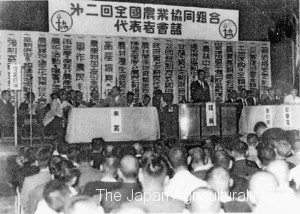Two legislations aiming for management reconstruction

The second National Nogyokyodokumiai (agricultural cooperatives) Representatives Congress held in September 1949
Facing financial difficulties, in November 1950, the third National Nogyokyodokumiai (agricultural cooperatives) Representatives Congress was held. The congress made resolution of development of “nogyokyodokumiai (agricultural cooperatives) progressive reform movement.” The resolution included 7 items of reconstruction development plan, such as “comprehensive plan of management business”, ” enhancement of the funds”, ” thorough nogyokyodokumiai (agricultural cooperatives) education.” Management slump of nogyokyodokumiai (agricultural cooperatives) had come to the point where reconstruction of their own was unable. Emphasis of exercise gradually changed to a request of financial assistance by the government. Later this congress developed into a national nogyokyodokumiai (agricultural cooperatives) congress.
The government had begun the study of the nogyokyodokumiai (agricultural cooperatives) reconstruction measures. Along with the financing measures to purchasing cooperatives for the time being, there was the idea that “by amending the Nogyokyodokumiai (agricultural cooperatives) Law, fund management of Nogyokyodokumiai (agricultural cooperatives) should be regulated.” However, this proposal was canceled in the opposite of the Allied Forces General Headquarters (GHQ) who thought that “it is not preferable for government to guide the agricultural cooperatives management”.
In April of this year, the government amended the Nogyokyodokumiai (agricultural cooperatives) Law, and determined “financial processing standards,” so as to strengthen the supervision of nogyokyodokumiai (agricultural cooperatives). In 1951, the government enacted the “Agriculture Fishery Cooperatives Reconstruction Development Law” in shape to meet the strong demand. This law aimed for making capital of cooperatives greater than the total amount of losses and fixed assets. It required to change bond and stock into cash, to make Five-year plan to make the financial situation adaptable for the standard, and to deliver the incentives by the track record.
While the reconstruction of cooperatives relatively well advanced, reconstruction of nogyokyodokumiai (agricultural cooperatives) federation was slow progress. There were 142 federation of nogyokyodokumiai (agricultural cooperatives) which was the subject of the Reconstruction Development Law. But reconstruction progress was tough, because the amount of loss per one federation was so large, and even member cooperatives of the federations were also in the reconstruction developing.
In August 1953, government established “Agriculture, Forestry and Fisheries Federation Development Promotion Law”, in order to make bottom-up of the federation. Its points were as follows;
1)permission of the extraordinary loss on the tax law, 2) interest should be subsidized by the national treasury, regarding financing by Norinchukin Bank and credit federation of nogyokyodokumiai (agricultural cooperatives). The government decided direct playback assistance of the interest subsidy. It was preferential treatment different from the rescue for nogyokyodokumiai (agricultural cooperatives).
Within the group of nogyokyodokumiai (agricultural cooperatives) which experienced management difficulties, it was emerged “management purification theory” which claimed that nogyokyodokumiai (agricultural cooperatives) should concentrate on purchase and sales business, rather than too much costly production guidance business. In 1948, the government started nogyokairyofukyuseido (agricultural extension service system), which was imported from the United States, and nogyokairyofukyuin (Agricultural extension service workers) had been deployed across the country.
On the other hand, after agrarian reform was settled down, 3 Committee related the reform such as nochiiinkai (farmland Committee), nogyochoseiiinkai (Agriculture Coordination Committee), and nogyokairyoiinkai (Agricultural extension Committee), were integrated into nogyoiinkai (agricultural committee) in July 1951. As a new business, Nogyoiinkai (agricultural committee) began the production technology guidance, which nokai (chamber of agriculture) had been doing before the war. Nosonkoseikyokai (Rural Rehabilitation Association) (Tadaatsu Ishiguro, president) showed the view supporting the idea of nogyoiinkai (agricultural committee) in March 1952. It was the proposal that the organization like former nojikai (chamber of farming) should be established in the different organization from nogyokyodokumiai (agricultural cooperatives). In contrast, nogyokyodokumiai (agricultural cooperatives) side expressed opposition immediately.
Conflict intensified regarding Guidance organization
From this time, the problem of agriculture organization restructuring was emerging as a major theme. Above all, it was actively argued regarding “how to create mentoring organization,” a facilitator of the entire nogyokyodokumiai (agricultural cooperatives).
In 1948, two organizations that became the mother of a central mechanism later were formed one after another. One was the “zenkokunokyorenrakukyogikai (National Nogyokyodokumiai (agricultural cooperatives) Council).” Its secretariat was composed by the former officials of sangyokumiai (cooperatives). The other was “noseikyogikai (Agricultural Policy Council),” whose secretariat was composed by the former officials of nokai (chamber of agriculture). Both organizations almost agreed with 3 principles on its business, which were “Organization guidance”, “production guidance,” and “Agricultural policy activities.” However, there was difference between each way of understanding. The differences surfaced, and developed into conflict.
“Zenkokunokyorenrakukyogikai (National Nogyokyodokumiai (agricultural cooperatives) Council) claimed that organizational activity should be comprehensive organization guidance, not simply managerial guidance. Its idea was that, in order to become the core of the guidance business, comprehensive organization guidance should be combined with education for board members and employees. This was the idea that inherited the traditional concept succeeded from sangyokumiaichuokai (general association of cooperatives).
In contrast, noseikyogikai (Agricultural Policy Council) claimed that, as in the former nokai (chamber of agriculture), based on the production guidance as foundation, all of the activities of nogyokyodokumiai (agricultural cooperatives) should be built up on it. Factions conflict of both advocates was intensifying, and its compromise seemed daunting.
Reference = ” Nogyokyodokumiai (agricultural cooperatives) institutional history, the second volume ” JC Research Institute, Liquidation office of National Guidance Federation of Nogyokyodokumiai (agricultural cooperatives) “zenshiren (National Guidance Federation of Nogyokyodokumiai (agricultural cooperatives)) history” the same office, Masaaki Ishida “History of JA and our role” Ienohikarikyokai

